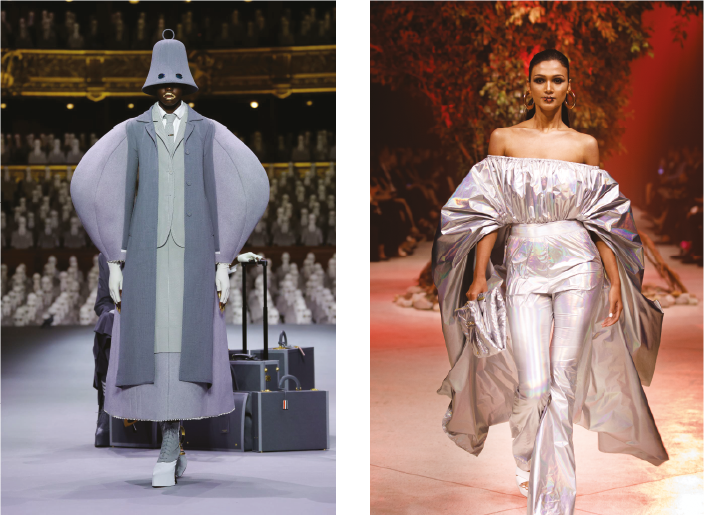As I prepared for the Bangladesh Wedding Couture Week (BWCW) 2023, I was riding a rollercoaster of emotions. On one hand, there is the stress and excitement of creating 32 distinct looks in just over two weeks. On the other hand, there are the post-show blues that I deal with for weeks after. There is no escaping all that, and, quite frankly, I am getting better at handling these emotions. But beyond this whirlwind, there is another challenge that designers face that I often find myself struggling to cope with – dealing with unconstructive criticism afterwards, particularly in the online realm.
Constructive criticism is part and parcel of my profession. As a designer, I know very well that I am putting my work out for the public to scrutinise and judge, to like it or not like it, and feedback is an important part of that. But it stings when criticism becomes personal, destructive, and lacks any substance.
WHEN I THINK ABOUT MY JOURNEY AS A DESIGNER, THE CHALLENGES POSED BY THE FASHION LANDSCAPE OFTEN EXTEND BEYOND MERE CREATIVE PURSUITS. IT INVOLVES NAVIGATING SOCIETAL NORMS AND EXPECTATIONS.
Every piece I send down the runway is very special to me. I have spent countless hours creating each one, and to put them out in the real world is unnerving at best. It is perhaps a similar feeling a parent has when their child goes to school for the first time. And like any protective parent, it is hard for me to not react when I hear remarks like, “Who would actually wear these?” or assertions like, “Men in Bangladesh won’t wear pink at their wedding.” Maybe these naysayers are right, and maybe men in Bangladesh do have rigid boundaries when it comes to fashion. But I cannot help but wonder, do I always have to showcase garments that must sell?

If you look closely at fashion shows anywhere in the world, more than half of the garments that designers showcase seldom reach retail shelves. They either go into the brands’ archives or are displayed in private corners of their flagship stores for special orders. Sometimes the designers will make a more toned-down and sellable version of runway pieces that you can buy. More often, runways serve as a canvas for artists to showcase their creativity, rather than being just a commercial marketplace. It is not solely about creating garments for everyday wear; it is about creating garments that transcend boundaries and reshape the perception of fashion today.
When I think about my journey as a designer, the challenges posed by the fashion landscape often extend beyond mere creative pursuits. It involves navigating societal norms and expectations. The rigidity of what is considered acceptable clothing for men or women can limit the scope of creativity and self-expression. Hence, when I am in the midst of designing a collection, I try not to pay attention to the voices around me who suggest I ‘tone it down’ or design within conservative colour confines of black, grey and blue. I try to stay as true to my vision and ensure that I am challenging myself to do better with each collection. I selfishly do all this for myself, so that I can go to bed knowing I’ve expressed my creativity confidently. If my mind gravitates towards dusty pink this season, I will absolutely put a male model in a full dusty pink ensemble. Despite the forthcoming unconstructive criticism. Sorry, not sorry!
But is it always all negative? No. For every unconstructive critic, there are those who appreciate and celebrate fashion’s artistic and transformative power.
IF YOU LOOK CLOSELY AT FASHION SHOWS ANYWHERE IN THE WORLD, MORE THAN HALF OF THE GARMENTS THAT DESIGNERS SHOWCASE SELDOM REACH RETAIL SHELVES. THEY EITHER GO INTO THE BRANDS’ ARCHIVES OR ARE DISPLAYED IN PRIVATE CORNERS OF THEIR FLAGSHIP STORES FOR SPECIAL ORDERS
They understand that the runway is not just a showcase of clothes; it is a stage for cultural reflection, a catalyst for dialogue, and a driving force for change. It is a place where designers challenge conventions, encourage inclusivity, and redefine beauty standards. They understand that fashion designers, through their runway showcases, are storytellers, weaving tales of creativity, innovation, and societal evolution. They understand that each collection is a chapter, contributing to the larger narrative of the fashion industry and its impact on the world.
Therefore, as a designer, utilising the runway as a platform to manifest my design ethos and make powerful statements is not just an option, but a responsibility-one that I take seriously, and where I will proudly contribute to the broader conversation on culture, identity, and change.
Hope to see you at my next fashion show!
Photographs: Collected

